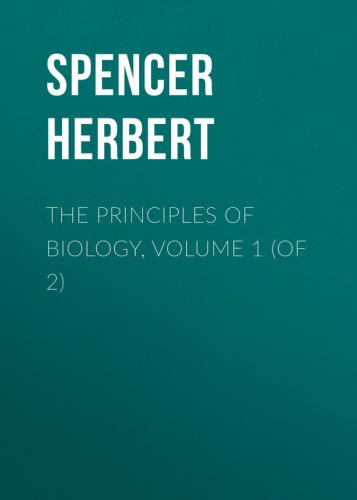If now, from this same point of view, we consider the relation borne to its environment by any superior organism in its successive stages, we find an analogous series of contrasts. Of course in respect of degrees of structure the parallelism is complete. The difference, at first small, between the little-structured germ and the little-structured inorganic world, necessarily becomes greater, step by step, as the differentiations of the germ become more numerous and definite. How of form the like holds is equally manifest. The sphere, which is the point of departure common to all organisms, is the most generalized of figures; and one that is, under various circumstances, assumed by inorganic matter. But as it develops it loses all likeness to inorganic objects in the environment; and eventually becomes distinct even from nearly all organic objects in its environment. In specific gravity the alteration, though not very marked, is still in the same direction. Development being habitually accompanied by a relative decrease in the quantity of water and an increase in the quantity of constituents that are heavier than water, there results a small augmentation of relative weight. In power of maintaining a temperature above that of surrounding things, the differentiation from the environment that accompanies development is marked. All ova are absolutely dependent for their heat on external sources. The mammalian young one is, during its uterine life, dependent on the maternal heat; and at birth has but a partial power of making good the loss by radiation. But as it advances in development it gains an ability to maintain a constant temperature above that of surrounding things: so becoming markedly unlike them. Lastly, in self-mobility this increasing contrast is no less decided. Save in a few aberrant tribes, chiefly parasitic, we find the general fact to be that the locomotive power, totally absent or very small at the outset, increases with the advance towards maturity. The more highly developed the organism becomes, the stronger grows the contrast between its activity and the inertness of the objects amid which it moves.
Thus we may say that the development of an individual organism, is at the same time a differentiation of its parts from each other, and a differentiation of the consolidated whole from the environment; and that in the last as in the first respect, there is a general analogy between the progression of an individual organism and the progression from the lowest orders of organisms to the highest orders. It may be remarked that some kinship seems to exist between these generalizations and the doctrine of Schelling, that Life is the tendency to individuation. For evidently, in becoming more distinct from one another and from their environment, organisms acquire more marked individualities. As far as I can gather from outlines of his philosophy, however, Schelling entertained this conception in a general and transcendental sense, rather than in a special and scientific one.
§ 54. Deductive interpretations of these general facts of development, in so far as they are possible, must be postponed until we arrive at the fourth and fifth divisions of this work. There are, however, one or two general aspects of these inductions which may be here conveniently dealt with deductively.
Grant that each organism is at the outset relatively homogeneous and that when complete it is relatively heterogeneous, and it necessarily follows that development is a change from the homogeneous to the heterogeneous – a change during which there must be gone through all the gradations of heterogeneity that lie between these extremes. If, again, there is at first indefiniteness and at last definiteness, the transition cannot but be from the one to the other of these through all intermediate degrees of definiteness. Further, if the parts, originally incoherent or uncombined, eventually become relatively coherent or combined, there must be a continuous increase of coherence or combination. Hence the general truth that development is a change from incoherent, indefinite homogeneity, to coherent, definite heterogeneity, becomes a self-evident one when observation has shown us the state in which organisms begin and the state in which they end.
Just in the same way that the growth of an entire organism is carried on by abstracting from the environment substances like those composing the organism; so the production of each organ within the organism is carried on by abstracting from the substances contained in the organism, those required by this particular organ. Each organ at the expense of the organism as a whole, integrates with itself certain kinds and proportions of the matters circulating around it; in the same way that the organism as a whole, integrates with itself certain kinds and proportions of matters at the expense of the environment as a whole. So that the organs are qualitatively differentiated from each other, in a way analogous to that by which the entire organism is qualitatively differentiated from things around it. Evidently this selective assimilation illustrates the general truth, set forth and illustrated in First Principles, that like units tend to segregate. It illustrates, moreover, the further aspect of this general truth, that the pre-existence of a mass of certain units produces a tendency for diffused units of the same kind to aggregate with this mass rather than elsewhere. It has been shown of particular salts, A and B, co-existing in a solution not sufficiently concentrated to crystallize, that if a crystal of the salt A be put into the solution, it will increase by uniting with itself the dissolved atoms of the salt A; and that similarly, though there otherwise takes place no deposition of the salt B, yet if a crystal of the salt B is placed in the solution, it will exercise a coercive force on the diffused atoms of this salt, and grow at their expense. Probably much organic assimilation occurs in the same way. Particular parts of the organism are composed of special units
